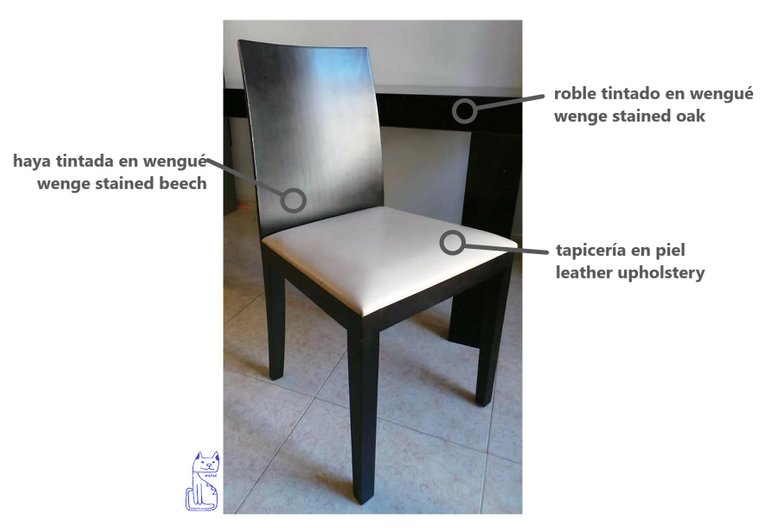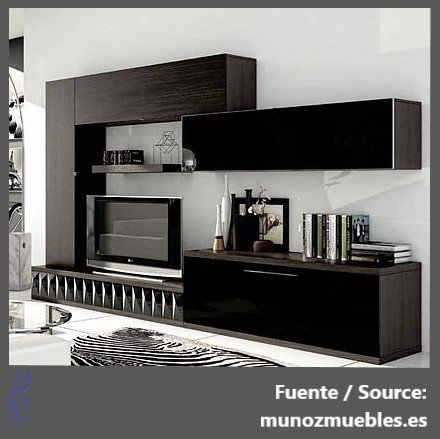¡Hola, Mundo!
Hace unos veinte años estaban muy de moda los muebles en color wengué. La madera de wengué es una de las más oscuras que existen, sobre todo si ha sido un árbol que ha recibido poca luz. Su nombre científico es Millettia laurentii y está seriamente amenazado, desde que hace unas décadas fuese tan deseado para su uso en carpintería y ebanistería, al ser de gran calidad y belleza. Sólo unos pocos "afortunados" podían comprar esa madera oscura y elegante, y pongo afortunados entre comillas, pues es una pena que sólo por el hecho de poder permitírtelo, se abuse de la compra de este tipo de materia, poniendo en peligro su existencia. Al resto de consumidores nos bastaba con el haya o el roble tintados en ese color, y a lo peor una melamina o formica simulando ese acabado. Eran diseños de líneas rectas, simples, minimalistas. Las puertas no tenían tiradores, o estaban integrados en el mueble, o eran finos y alargados. Pura sencillez. Se combinaban con colores neutros, como el blanco o el crudo, todo muy homogéneo y frío.
Pero las modas pasan, y todos nos fuimos cansando de esta también.
Hi, World!
About twenty years ago, wenge coloured furniture was very fashionable. Wenge wood is one of the darkest woods in existence, especially if it has been a tree that has received little light. Its scientific name is Millettia laurentii and it is seriously endangered, since a few decades ago it was so desired for its use in carpentry and joinery, as it is of great quality and beauty. Only a few "lucky" people could buy this dark and elegant wood, and I say "lucky" in inverted commas, because it is a pity that just because you can afford it, the purchase of this type of material is abused, endangering its existence. For the rest of the consumers, beech or oak stained in that colour was enough, and at worst a melamine or formica simulating that finish. They were straight-lined, simple, minimalist designs. The doors had no handles, or they were integrated into the furniture, or they were thin and elongated. Pure simplicity. They were combined with neutral colours, such as white or ecru, all very homogeneous and cold.
But fashions pass, and we all got tired of this one too.


Ya en su día me decidí a pintar los muebles del salón que eran de una formica imitando el wengué. Fue un trabajo sencillo, gracias a la sencillez del diseño de estos muebles. Tan sólo tuve que frotarle acetona con un paño a toda la superficies, para aplicarle posteriormente la imprimación. Finalmente, con un rodillo pinté dos capas de acrílica satinada. Le cambié los tiradores de frío aluminio por unos pomos de porcelana en el mismo tono de blanco, y les atornillé unas ruedas giratorias a cada módulo. El efecto resultante fue muy original: la mezcla de una estructura muy moderna y actual con unos acabados y texturas antiguas.
Pasaron los años y seguía sin tener claro qué hacer con la mesa y las sillas. Todas ellas eran de madera, y podía tener más opciones de acabado que el mueble de formica. Lo que sí sabía seguro era que no compraría muebles nuevos. No quería contribuir a la deforestación ni tampoco a contaminar con la producción de materiales plásticos. Y por otro lado, ¿qué haría con mis muebles viejos? Regalarlos sería la salida más sostenible, pero ¿quién iba a quererlos? ¿Tirarlos? ¡Ni hablar! Me los quedaría, por supuesto, aunque tuviese que aguantar ese oscuro color que ya no me agradaba tanto.
Back in the day I decided to paint the living room furniture, which was made of formica imitating wenge. It was a simple job, thanks to the simplicity of the design of this furniture. I only had to rub acetone with a cloth on all the surfaces, and then apply the primer. Finally, with a roller I painted two coats of satin acrylic. I replaced the cold aluminium handles with porcelain knobs in the same shade of white, and screwed swivel wheels to each module. The resulting effect was very original: the mixture of a very modern and contemporary structure with antique finishes and textures.
Years went by and I was still not sure what to do with the table and chairs. They were all made of wood, and I could have more choice of finish than the Formica furniture. What I knew for sure was that I would not buy new furniture. I didn't want to contribute to deforestation and I didn't want to pollute by producing plastic materials. On the other hand, what would I do with my old furniture? Giving it away would be the most sustainable way out, but who would want it? Throwing it away? No way! I would keep them, of course, even if I had to put up with that dark colour that I no longer liked so much.


La mesa era de roble y las sillas eran de haya, todas con un tinte con un acabado muy oscuro, simulando el wengué. Y por fin decidí "meterles mano". Comencé probando con una de las sillas, desmonté el asiento, que estaba tapizado en piel blanca y me puse a lijar. La tarea llegó a ser desesperante, os explico: si hubiesen estado barnizadas, la lija arrastraría el barniz hasta dejar la madera limpia, pero en este caso la madera estaba tintada. El acabado es sedoso y elegante, pero si quieres eliminar ese color, pues resulta una tarea casi imposible. En las zonas donde había uniones o ensamblajes era muy complicado el acceso de la lija. Y en los extremos de los listones de las patas y el asiento, el tinte había penetrado veta adentro. Sé que hay productos para blanquear la madera, pero hay otras formas de decorar estas sillas, y yo di con una de ellas: las pintaría, simplemente, para cubrir el color oscuro.
Así que os voy a contar cómo he preparado la madera y la he pintado, y cómo he tapizados los asientos. Después veremos el resultado en el conjunto completo del hogar. ¿Seguirás conmigo para verlo? ¿Quieres comprobar cuánto puede cambiar un mueble con una mano de pintura y un cambio en los textiles? Puedes integrar casi cualquier elemento en tu hogar y hacerlo tuyo, ¿no es fantástico?
The table was oak and the chairs were beech, all with a very dark stain finish, simulating wenge. And at last I decided to "give them a hand". I started by trying one of the chairs, I dismantled the seat, which was upholstered in white leather, and I started sanding. The task became desperate, I explain: if they had been varnished, the sandpaper would drag the varnish until the wood was clean, but in this case the wood was stained. The finish is silky and elegant, but if you want to remove that colour, it is an almost impossible task. In the areas where there were joins or joints, it was very difficult to access the sandpaper. And at the ends of the leg slats and the seat, the dye had penetrated deep into the grain. I know there are products to whiten wood, but there are other ways to decorate these chairs, and I found one of them: I would simply paint them to cover the dark colour.
So I'm going to tell you how I prepared the wood and painted it, and how I upholstered the seats. Then we'll see the result in the whole home, will you follow me to see it? Do you want to see how much a piece of furniture can change with a coat of paint and a change of textiles? You can integrate almost any element into your home and make it your own, isn't it fantastic?
Gracias por leerme. Encantada de tenerte por aquí 💛
Te doy la bienvenida a miAu!
Traducido gracias a la versión gratuita de www.DeepL.com/Translator
Thank you for reading me. Nice to have you around.
I welcome you to miAu!Translated with www.DeepL.com/Translator (free version)

Gracias por vuestro apoyo, @sancho.panza